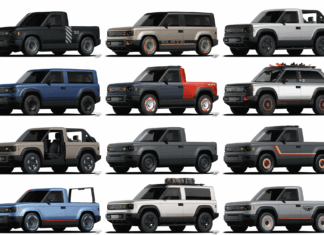
Some of Ford’s 2.7L and 3.0L EcoBoost engines may harbor a catastrophic problem.
By sheer sales numbers, you could reasonably argue that the revived Ford Bronco has been one of the Blue Oval’s major successes of the decade so far. That success hasn’t come without its problems, though, and here’s another we can officially add to the list: a new recall affecting more than 90,000 vehicles including early examples the explosively popular Bronco, as well as the even more popular Explorer, the Edge, and the Lincoln Aviator and Nautilus SUVs, as well as the F-150 pickup.
Specifically, some engines may have intake valves prone to fractures or braking, which would in turn cause catastrophic engine damage. If that happens, drivers (naturally) lose motive power, and that may increase the risk of an accident, apart from leaving them stranded. Ford says through a chronology report submitted to the NHTSA that it began looking into the problem in January 2022, with the Lincoln Aviator and Nautilus. Throughout the following months, the company expanded its investigation to other models equipped with the 2.7-liter and 3.0-liter ‘Nano’ EcoBoost engines.
As of August 9, 2024, Ford says it is aware of 811 global warranty claims related to the issue, with report dates ranging between February 13, 2021 and June 3, 2024. It is also aware of 267 field reports and 223 customer reports claiming severe engine damage from defective intake valves between 2020 and 2023.
Of the 90,736 vehicles covered under the recall, here’s how the situation breaks down by model:
| (Year) Model | Engines | Affected Units | Starting Build Date | Ending Build Date |
|---|---|---|---|---|
| 2021-2022 Ford F-150 | 2.7L | 47,719 | May 1, 2021 | October 31, 2021 |
| 2021-2022 Ford Bronco | 2.7L and 3.0L | 15,835 | May 1, 2021 | October 30, 2021 |
| 2021-2022 Ford Explorer | 3.0L | 14,262 | June 7, 2021 | October 31, 2021 |
| 2021-2022 Ford Edge | 2.7L | 2,366 | May 10, 2021 | October 29, 2021 |
| 2021-2022 Lincoln Aviator | 3.0L | 7,199 | June 7, 2021 | October 31, 2021 |
| 2021-2022 Lincoln Nautilus | 2.7L | 3,355 | May 10, 2021 | October 29, 2021 |
As Ford explained the problem to the NHTSA, the problematic intake valves “may have grinding burn and over-specification hardness at the third keeper groove location in the valve.” The valves were supplied by Eaton Corporation, from its manufacturing plant in Kearney, Nebraska.
Signs of the problem and Ford’s fix
Even before this recall campaign, problems with 2.7-liter and 3.0-liter EcoBoost engines grenading themselves have garnered widespread discussion over the past couple years. A probe by the NHTSA’s Office of Defects Investigation kicked off in October 2023 to determine the scale of the problem, with the investigation including no fewer than 708,837 vehicles across some of Ford’s most popular lineups.
The automaker notes owners may see an engine malfunction indicator light and possibly experience the vehicle running rough before full-on engine failure and loss of motive power.
Ford says it will notify owners of the problem as part of this recall campaign by October 11. Dealers will receive notification on the recall and the remedy by the end of September.
To fix the problem, dealer technicians will inspect the cumulative number of engine cycles and conduct an “engine cycle accumulation test” on each vehicle, and replace engines of vehicles that fail that test at no cost to the owner. Those who paid out to fix the the problem prior to the official recall may be eligible for reimbursement. A decent portion of these vehicles should still be within their manufacturer warranty, but those who drive longer distances (like F-150 owners, for example) may need to take the reimbursement route.
Replacement engines, Ford says, are manufactured with intake valves that are within the automaker’s specification for hardness.














































